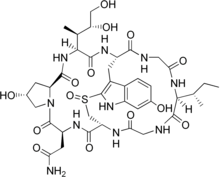Cyclic peptide



Cyclic peptides are polypeptide chains which contain a circular sequence of bonds. This can be through a connection between the amino and carboxyl ends of the peptide, for example in ciclosporin; a connection between the amino terminus and a side chain, for example in bacitracin; the carboxyl terminus and a side chain, for example in colistin; or two side chains or more complicated arrangements, for example in amanitin. Many cyclic peptides have been discovered in nature and many others have been synthesized in the laboratory. Their length ranges from just two amino acid residues to hundreds. In nature they are frequently antimicrobial or toxic; in medicine they have various applications, for example as antibiotics and immunosuppressive agents.[1]
Classification of cyclic peptides
Cyclic peptides can be classified according to the types of bonds that comprise the ring.
- Homodetic cyclic peptides, such as cyclosporine A, are those in which the ring is composed exclusively of normal peptide bonds (i.e. between the alpha carboxyl of one residue to the alpha amine of another). The smallest such species are 2,5-diketopiperazines,[2] being derived from the cyclisation of a dipeptide.
- Cyclic isopeptides contain at least one non-alpha amide linkage, such as a linkage between the side chain of one residue to the alpha carboxyl group of another residue, as in microcystin and bacitracin.
- Cyclic depsipeptides, such as aureobasidin A and HUN-7293, have at least one lactone (ester) linkage in place of one of the amides. Some cyclic depsipeptides are cyclized between the C-terminal carboxyl and the side chain of a Thr or Ser residue in the chain, such as kahalalide F, theonellapeptolide, and didemnin B.
- Bicyclic peptides such as the amatoxin amanitin and the phallotoxin phalloidin contain a bridging group, generally between two of the side chains. In the amatoxins, this bridge is formed as a thioether between the Trp and Cys residues. Other bicyclic peptides include echinomycin, triostin A, and Celogentin C. There are a number of cyclic peptide hormones which are cyclized through a disulfide bond between two cysteines, for example somatostatin and oxytocin.
Biosynthesis and applications
Cyclic peptides tend to be extremely resistant to the process of digestion, enabling them to survive in the human digestive tract.[3]
Examples include:
See also
References
- ^ Jensen, Knud (2009-09-01). Peptide and Protein Design for Biopharmaceutical Applications. John Wiley & Sons. ISBN 9780470749715.
- ^ Borthwick AD (May 2012). "2,5-Diketopiperazines: Synthesis, Reactions, Medicinal Chemistry, and Bioactive Natural Products". Chemical Reviews. 112 (7): 3641–3716. doi:10.1021/cr200398y. PMID 22575049.
{{cite journal}}: CS1 maint: year (link) - ^ David J. Craik (17 March 2006). "Seamless Proteins Tie Up Their Loose Ends". Science. 311 (5767): 1563–7. doi:10.1126/science.1125248. PMID 16543448.
External links
- Cybase
- Cyclic+Peptides at the U.S. National Library of Medicine Medical Subject Headings (MeSH)
